The Roman Legions have fired the imaginations of many generations of people.
A Roman legion was a large unit of the Roman army.
…
For most of the Roman Imperial period, the legions formed the Roman army’s elite heavy infantry, recruited exclusively from Roman citizens, while the remainder of the army consisted of auxiliaries, who provided additional infantry and the vast majority of the Roman army’s cavalry (Provincials who aspired to citizenship gained it when honourably discharged from the auxiliaries). The Roman army, for most of the Imperial period, consisted mostly of auxiliaries rather than legions.
For example:
The Legio XX Valeria Victrix narrative has fired the imaginations of many creative writers.
Legio vigesima Valeria Victrix, in English Twentieth Victorious Valeria Legion was a legion of the Imperial Roman army.
…
Legio XX Valeria Victrix and their final days in Deva (Chester) in the early AD 400s form the backdrop to the Tom Stevens mythic fiction genre novel The Cauldron (special edition)… featured in the novel Eagle in the Snow; author Wallace Breem… in the early novels of Jack Whyte‘s A Dream of Eagles series… Stephen Vincent Benét‘s short story “The Last of the Legions”… features in the six novel series “Soldier of Rome – The Artorian Chronicles” by James Mace.
However, there are many knowledge gaps in the Legio XX Valeria Victrix narrative.
1) The year Legio XX Valeria Victrix was founded.
The legion was probably founded shortly after 31 BC by the emperor Augustus.
XX Valeria victrix was probably part of the large Roman force that fought in the Cantabrian Wars in Hispania from 25 to 19 BC.
2) Whether Legio XX Valeria Victrix was recruited exclusively from Roman citizens.
to 9 AD Burnum… Dalmatia (Croatia/Bosnia/Serbia)
3) The origins of the name acquired by Legio XX Valeria Victrix.
The origin of the Legion’s name is unclear and there are various theories…
4) The year Legio XX Valeria Victrix ceased to exist.
… scholars believe the XX legion was still stationed in Britain when the usurper Constantine III pulled the bulk of the military forces from there in the year 407 for his doomed campaign on the continent.
The problem being:
Specific narrative references to Legion XX are limited to the first century.
Legio XX Valeria Victrix: A Prosopographical And Historical Study
Stephen James Malone – 2005 – University of Nottingham
http://eprints.nottingham.ac.uk/13316/UK: https://www.amazon.co.uk/dp/1841719226
US: https://www.amazon.com/dp/1841719226Side Bar
This excellent thesis by Stephen James Malone mentions the “British Empire of Carausius and Allectus” aka Britannic Empire aka Carausian Revolt.The Carausian Revolt (AD 286–296) was an episode in Roman history, during which a Roman naval commander, Carausius, declared himself emperor over Britain and northern Gaul.
His Gallic territories were retaken by the western Caesar Constantius Chlorus in 293, after which Carausius was assassinated by his subordinate Allectus.
Britain was regained by Constantius and his subordinate Asclepiodotus in 296.
The “limits” of the “British Empire of Carausius and Allectus” are very intriguing!
Looking more generally at the Roman Legions it quickly becomes apparent the data is fatally flawed because the knowledge gaps are deep crevasses.
The Wikipedia history of the Roman Legions neatly sidesteps the long list of civil wars during the Crisis of the Roman Republic [133 to 30 BC] by simply mentioning Augustus “disbanded about half of the over 50 legions” in 31 BC.
When Augustus became sole ruler in 31 BC, he disbanded about half of the over 50 legions then in existence.
The remaining 28 legions became the core of the early Imperial army of the Principate (27 BC – 284 AD), most lasting over three centuries.
…
The numbering of the legions is confusing, since several legions shared the same number with others. Augustus numbered the legions he founded himself from I, but also inherited numbers from his predecessors.https://en.wikipedia.org/wiki/List_of_Roman_legions
The Crisis of the Roman Republic – an extended period of political historical unrest, from about 133 BC to 30 BC.
This fine finesse helps mask the massive turmoil experienced by the Roman Legions between 59 and 31 BC when 27 Roman Legions were founded [graphed] and “about half of the over 50 legions” were disbanded [not graphed – no data] in 31 BC.
Data source: https://en.wikipedia.org/wiki/List_of_Roman_legions
In other words:
This fine finesse appears to mask the very catastrophic fact that there was only one functioning Roman Legion in 60 BC.
This initial build-up is followed by a period of almost a century when 3 Roman Legions are founded and 3 Roman Legions are disbanded.
Apparently, the Roman Empire didn’t need to steadily increase the number of Roman Legions as the empire expanded towards it’s “greatest extent” in 117 AD.
The empire reached its greatest extent under Trajan…
https://en.wikipedia.org/wiki/Roman_Empire
Trajan was Roman emperor from 98 to 117 AD.
https://en.wikipedia.org/wiki/Trajan
See: https://malagabay.wordpress.com/2016/01/24/semicircular-europe-and-the-heinsohn-horizon/
Instead, there is one short period of turmoil between 66 and 70 AD, when 5 Roman Legions are disbanded and 7 Roman Legions are founded.
This period of turmoil is associated with the Year of the Four Emperors in 69 AD.
It seems the primary driver for reconfiguring the Roman Legions was civil war.
The Year of the Four Emperors, 69 AD, was a year in the history of the Roman Empire in which four emperors ruled in succession: Galba, Otho, Vitellius, and Vespasian.
The suicide of the emperor Nero in 68 was followed by a brief period of civil war, the first Roman civil war since Mark Antony’s death in 30 BC.
https://en.wikipedia.org/wiki/Year_of_the_Four_Emperors
Data source: https://en.wikipedia.org/wiki/List_of_Roman_legions
It’s the disbanded dates that reveal just how legendary the Roman Legion are.
The data reveals no Roman Legions were disbanded between 140 and 240 AD.
Furthermore:
All the disbandment dates between 250 and 500 AD are guesstimates because none of these dates are actually known.
Data source: https://en.wikipedia.org/wiki/List_of_Roman_legions
The data also suggests most of the Roman Legions are 300 Year Repeaters that participated in re-branded narrative re-enactments [some] 300 to 500 years after the primary event.
300 YEAR “REPEATERS”
My claim that, during the 8th-10th century CE, Imperial Antiquity (1st-3rd c. CE), Late Antiquity (4th-6th c.) and the Early Middle Ages (8th-10th c. CE) run side by side, is stratigraphically justified.
That parallelism allows the reconnection of artificially separated sources resulting in more complete historical narratives.
…
The reader will decide for himself whether the similarities over 300 years may be explained by chance alone.Gunnar Heinsohn
See: https://malagabay.wordpress.com/2018/04/19/gunnar-heinsohn-comments-on-300-year-repeaters/
Finally, in an ironic twist of fate, the life expectancy of a newly founded Roman Legion reached ZERO during the 230s AD.
The moral of this story, it’s simple but it’s true
Hey thestarssources might lie, but the numbers never doI Feel Lucky – 1992 – Mary Chapin Carpenter and Don Schlitz
Gunnar Heinsohn very politely points out the 700 years between the 230s and 930s AD “have neither strata nor tree samples”.
Therefore, some 700 years of the 1st millennium (230 to 930s) have neither strata nor tree samples for C14 or dendro-chronological dating.
Archaeological Strata Versus Baillie’s Tree-Rings: Proposal for an Experiment
Gunnar Heinsohn – 8 Sept 2014See: https://malagabay.wordpress.com/2017/09/11/the-heinsohn-horizon-and-the-migration-period/
I guess Gunnar Heinsohn is fully entitled to say: “I told you so!”.
See: https://malagabay.wordpress.com/2018/04/19/gunnar-heinsohn-comments-on-300-year-repeaters/

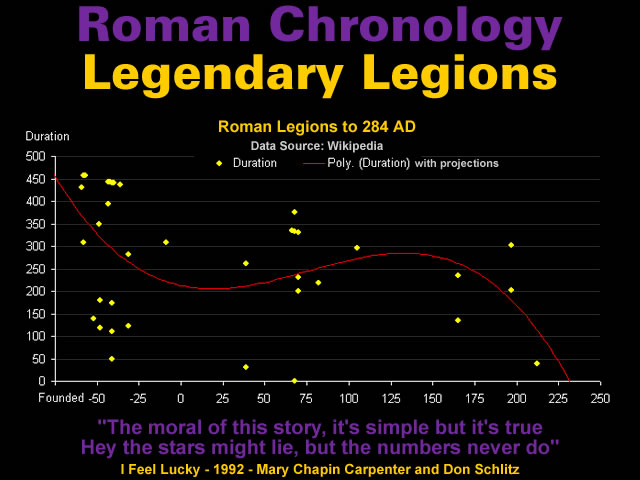

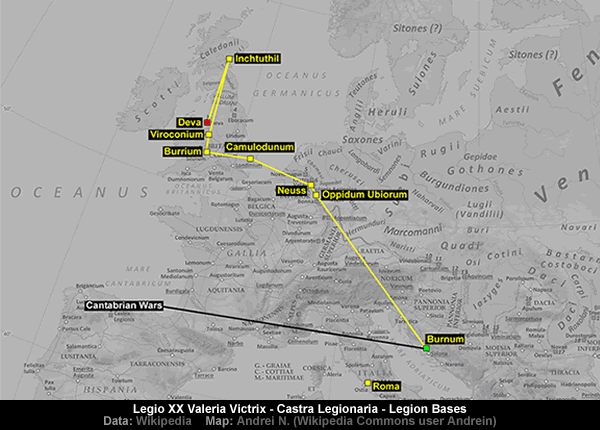
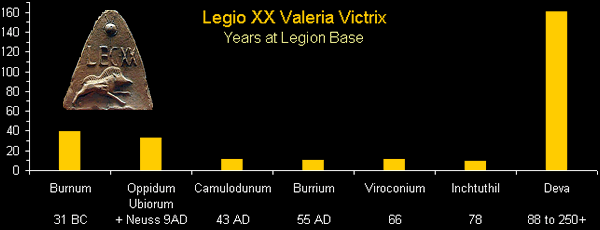
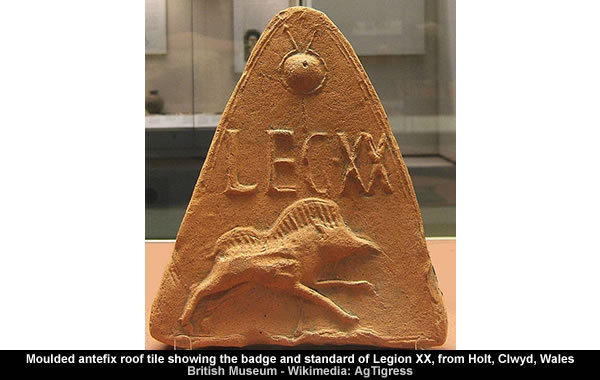

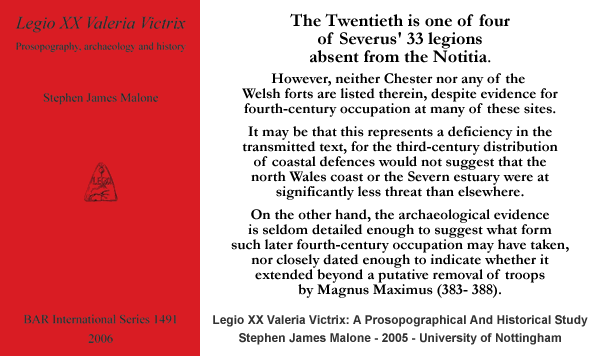

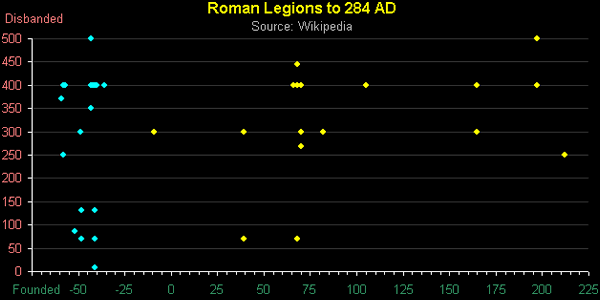




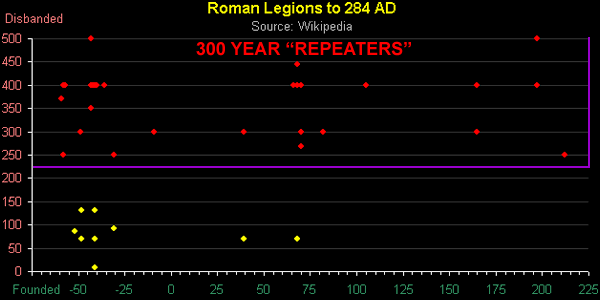
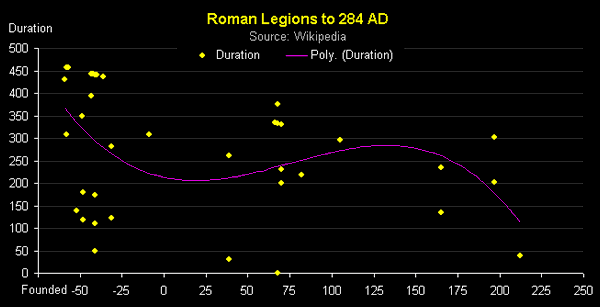

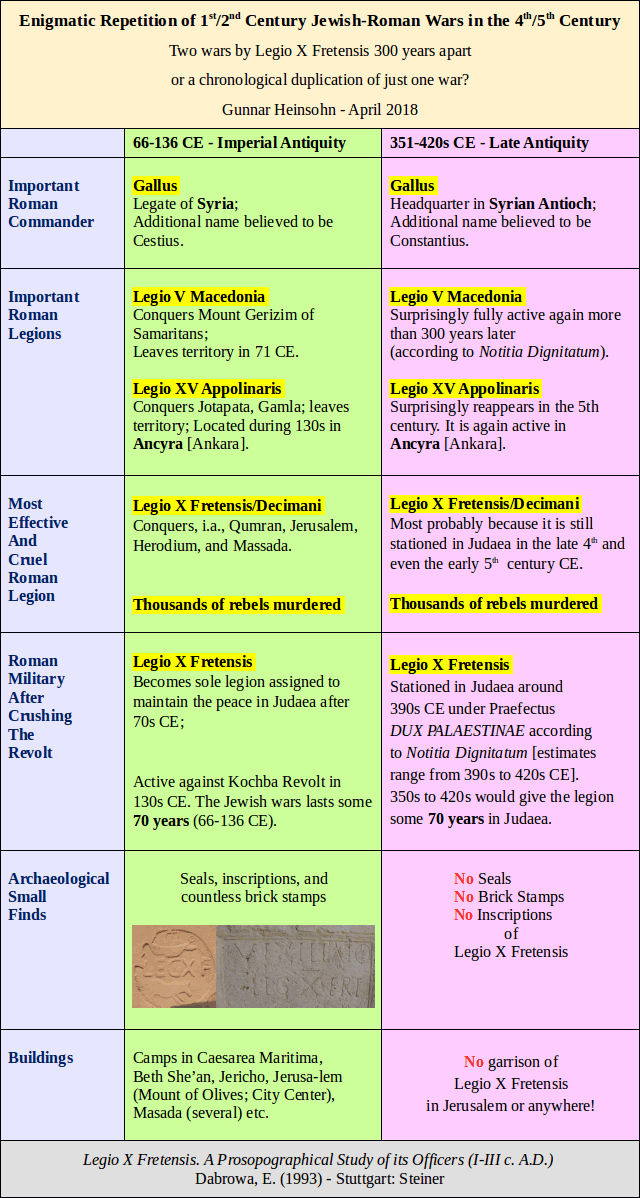
Gunnar’s claim of a 300 year repetition in Roman-Jewish wars is absurd. Especially as at least one major Roman historian living at the time of the 4th century one refers to the first century war as an entirely different and much larger affair. And in no case do historians of either war give the slightest hint that personalities from the other war coexisted at the same time.
The Byzantine stratigraphy of Palestine in the 4th and 5th centuries is rich, abundant and radically different from the remains of the first century.
One lifelong researcher in these fields is Ralph Amelan who was for many years Secretary of the British Society for Interdisciplinary Studies. With his permission, I attach his comments:
“Trying to claim that two separate Jewish revolts were really one. This is peculiar. I have no objection to 300 year gaps (which is all he is really claiming here) but the accounts dealing with the Jewish sources about the 350-400 revolt seem to be dealing with a messianic pretender which could be a repeat of Bar Kochba, but then the gap is much smaller: about 230 years. Also, the places of the revolts are different, and the well-attested Jewish death toll is vastly higher in the Bar Kochba revolt alone, never mind the 70 AD Tisha B’Av bloodbath (That destroyed the Second temple).
“Heinsohn simply says “thousands of rebels killed” for both the 66 – 136 column, and the 350 – 400 column: grossly misleading.
“I (Amelan) quote the Roman (actually Greek, but he sat as a senator) Dio Cassio as to what he wrote about both revolts: the destruction of the Temple here:
Cassius Dio — Epitome of Book 65
“The casualty figures listed by Dio in the Bar Kochba revolt runs to half a million (Five hundred and eighty thousand men). Granted this is likely inflated, but still…
“And where is Vespasian #2? Where is Titus #2? Where is Hadrian #2? Where is Severus #2?
“Some of his researches in European archaeological sites are very suggestive, and to me make a good prima facie case for chronological holes. But this is slipshod. I would not mind if he (Heinsohn) acknowledged this and said that he could not as yet find an answer. But this…..”
Cassius Dio — Epitome of Book 65
An English translation; part of a complete English translation of Dio. Site contains many Greek and Latin texts,…
and the suppression of Bar Kochba, here:
Cassius Dio — Epitome of Book 69
It simply is not true that there is a 700 year gap (In what locations precisely? – presumably across the entire Roman Empire of Most of Europe, the Mediterranean, England, North Africa and the Middle East?) from 230 AD to 930 AD.
Heinsohn has yet to tackle the archaeology of Anglo-Saxon London, a strata from 200 years from the eighth century through the ninth century – That has been excavated in the past 15 years.
Unless Heinsohn can argue away or re-date the existence of Anglo-Saxon London, THE HEINSOHN HORIZON for a 700 year Dark Age Gap CANNOT EXIST.
The Byzantine strata in the Land and of Israel/Palestine are abundant and in full agreement with the descriptions in by Byzantine Christian historians from Eusebius in the time of Constantine all the way through to the Secret History of Procopius under Justinian.
We now even have the likelihood Charlemagne’s own body excavated in recent years at Aachen
British archaeologists have no difficulty finding, excavating and documenting repeated Roman settlement and rebuilding (which strongly supports major but not yet annihilating catastrophes in the third and fourth centuries AD all the way down to the fifth century, when real darkness does descend.
All of this appears to confirm Heribert Illig’s crucial and brilliant pioneering work.
Dear Martin!
A few words re “The Byzantine stratigraphy of Palestine in the 4th and 5th centuries is rich, abundant and radically different from the remains of the first century”. Pars pro toto I will focus on Tiberias – the most important city for Jews after Jerusalem’s Jewry was murdered.
Of three urban strata packages (Imperial Antiquity, Late Antiquity, Early Middle Ages) expected for Tiberias’s Jews during the 1st millennium CE only one, Late Antiquity (LA) could be furnished with synagogues. That is a bewildering situation for a place that, together with Jerusalem, Hebron and Safed, was one of Judaism’s four holy cities during the 1st millenium CE.
Tiberias‘ 1st/2nd c. rich pagan urban context of Imperial Antiquity (IA) to this very day leaves experts perplexed by the absence of simultaneous synagogues although the city, built under Herod Antipas (ca. 20 BCE-39 CE) between 18 and 22 CE, is supposed to have accomodated a Jewish majority. No less surprising is Tiberias of Late Antiquity (LA) because new Roman palaces and other stately buildings expected after the decay and destruction during the Third Century Crisis (230s -284 CE) have left no traces whatsoever. Therefore, it is not understood where Diocletian (284-305 CE) took residence when, in 286 CE, he spent a full three months in Tiberias (Barnes, T.D. (1982), The New Empire of Diocletian and Constantine, Cambridge/Mass & London: Harvard University Press, 50). However, on Mt. Berenice, a Christian church is added, and dated to Late Antiquity. Surprisingly though it is built in the 300 year earlier basilica style of Imperial Antiquity (IA).
However, at least two synagogues, Limestone Menorah [conventionally 286-337 CE] as well as Severus [conventionally late 4th c. CE]), are built in Tiberias of Late Antiquity. However, there is no rabbinical information whatsoever about Jews in Tiberias after the Sanhedrin was moved there in 175/193 CE. Thus, when there is undisputable Jewish history for Tiberias in Imperial Antiquity (1st-3rd c.) there is no Jewish architecture. When, in 4th c. Late Antiquity, there are no Jewish sources about Jews in Tiberias the city suddenly exhibits impressive synagogues that are so mysteriously missing for the 1st c. CE.
Yet, the confusion does not end here: When Tiberias eventually becomes the unchallenged heart of Jewish intellectual life in the Early Middle Ages of the Masoretic schools (EMA; 700-930s CE) neither synagogues nor other Jewish landmarks of the expected urban blossoming are built. Even residential buildings and latrines are missing. Moreover, what is left of Imperial and Late Antiquity’s splendour – like the 7,000 seat theatre or the Christian basilica on Mt. Berenice – is wiped out by a massive conflagration conventionally dated to the middle of the 8th c. CE. Exactly when, around 700 CE, the Masoretes are gearing into full speed to add vowels to the Hebrew Bible (Tanakh of 100/135 CE) Tiberias becomes uninhabitable. Yet, none of the Masoretic literature gives any hint whatsoever about this cataclysmic event.
Thus, if we want to connect Jewish life in Tiberias to the synagogues of Tiberias we have material evidence for just one of the three periods of our textbooks.
Cordially, Gunnar
Roman legions are indeed an ideal material for the review of our textbook chronology. Historians compile the text sources and distribute them into the accepted framework between the time of the Republic and the 7th century CE. Archeologists then try to stretch the scarce hard evidence over these centuries. Everyone fails and many despair. Whenever I enter a debate I will try to focus it on one or more legions. They must have had fortified structures that leave indelible traces. And yet, nowhere are they sufficient for seven centuries or even more.
Gunnar Heinsohn
Pingback: Roman Chronology: Credibility Gap | MalagaBay
Reblogged this on Die Goldene Landschaft.
Pingback: Enigmatic Egypt: Roman Ruination – Red Sea Hills | MalagaBay
Pingback: Daniel Man of Visions and Dreams
Pingback: Shaping The Saxon Shore | MalagaBay
Pingback: Bordeaux Brickwork | MalagaBay
Pingback: Ptolemy’s Paradigm: Aftermath | MalagaBay